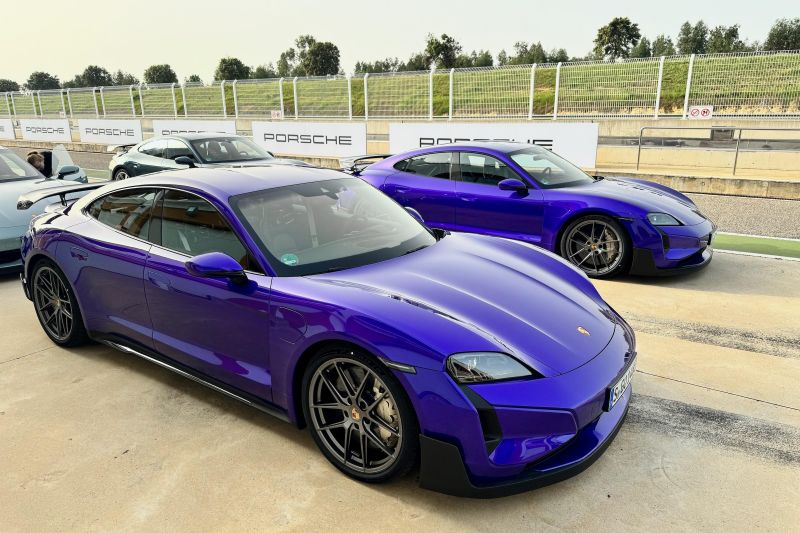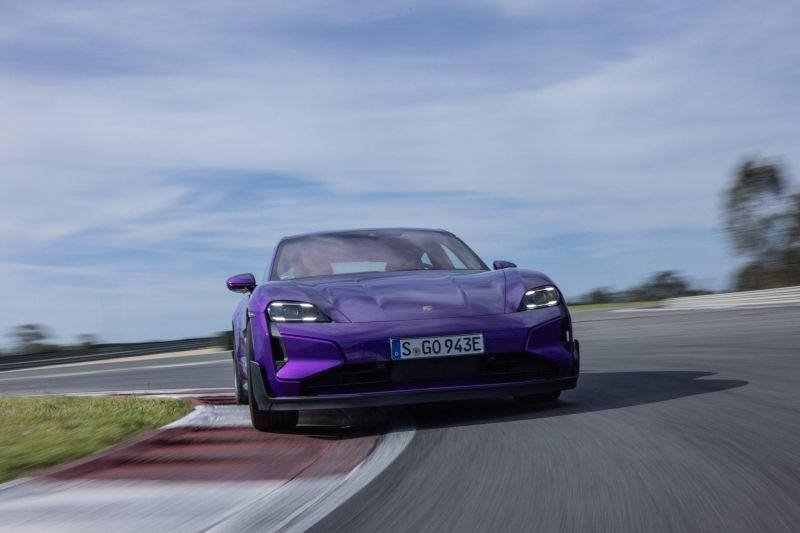If the standard Porsche Taycan range is not hardcore enough for you, the Germans now have a new solution in the 2024 Porsche Taycan Turbo GT.
This is arguably a car that no one asked for, but most will want after a quick drive. It’s what happens when the brief to the engineers is ‘make it go as fast as possible’.
It will go around the world famous race track of Laguna Seca faster than a brand new 992-generation 911 GT3 RS. It can lap the 20.8km Nürburgring Nordschleife circuit in just 7 minutes, 7.55 seconds, making it 26 seconds quicker than the previous Taycan Turbo S, 2.5 seconds quicker than the Tesla Model S Plaid, and most impressively only about 3.0 seconds slower than the outright EV record, held by the $3.5m Rimac Nevara hypercar.
That’s a very convoluted way of telling you, it’s f**ing fast – if you want to know what that really feels like, watch the video below.
We hear car companies talk endlessly about cost efficiencies, economies of scale and all those buzzwords that make accountants excited, but the Turbo GT is the opposite of all of those things.
It’s a car that really wanted to be a two-door long coupe but the accountants said no. So the engineers said ‘that’s fine, we will just take out the back seats then!’ and while everyone thought they were kidding, they actually did.
That’s right, the Porsche Taycan Turbo GT can be optioned (for free!) with the Weissach package, which adds a fixed wing, more carbon and loses the two rear seats.
This would have to be the first electric four-door two seater in the world and – frankly – it makes absolutely no sense. Which is why we love it.
In an ideal world, Porsche would have reengineered the chassis to be a two door and this would have been an instant icon, but the cost of retooling and retesting the vehicle for such a small niche client base made that unfeasible.
If you are thinking about this car from the perspective that it’s going to a practical daily or whatever you want to tell yourself to justify the $416,600 price tag (think closer to $500k with a few options and on-road costs), you’re looking at it wrong.
This is a car to sit amongst a collection of other cars. It’s the sort of car that people buy so they can go downstairs to their garage and say to a friend: ‘go on, open the back doors’.
It’s also the sort of car that can teach you a lot about physics. While it still weighs 2234kg (with the Weissach package), it is so incredibly fast it’s as quick to 100km/h as a modern Formula 1 car.
| 0-100km/h | 0-160km/h | 0-200km/h | Top Speed | |
|---|---|---|---|---|
| Taycan Turbo GT | 2.3 | 4.5 | 6.6 | 290km/h |
| Taycan Turbo GT Weissach | 2.2 | 4.4 | 6.4 | 305km/h |
To get that extra few milliseconds of speed, Porsche had the option of making the battery pack a little smaller… or remove a whole bunch of things to reduce the weight by around 70kg.
Given that creating a specific battery just for the Turbo GT would have made the accountants kill the project and therefore out of the question, opting to get the Weissach package takes out not only the already mentioned rear seats, but also the analog clock, floor mats (available as a no-cost option), Bose sound system and electrically opened charging port.
Basically, Porsche will take a whole bunch of things out and – graciously – not charge you for the process. Power and torque figures are unaffected between the standard and Weissach versions of the Taycan.
| Power | Power with LC | Torque with LC | |
|---|---|---|---|
| Taycan Turbo GT & Weissach | 580kW | 760kW | 1340Nm |
The range for the lighter model is slightly better at between 538-555 km, as opposed to 528-554 km for the more practical four-seater version. You can read our standard Taycan review to see all the things Porsche has done to improve the battery cooling and recharging capacity.
All that aside, the Turbo GT is experienced best from the driver’s seat on a long stretch of road or race track. Porsche brought us out to a race track in the outskirts of Sevilla in Spain, whereby we got to make ourselves carsick with endless laps and acceleration runs.
It’s one thing to tell you it will do 0-100km/h in 2.2 seconds, but it’s another thing to feel it. Then to keep going to 200km/h in 6.4 seconds is utterly absurd (you must watch the video above).
In fact, when we timed it on video for our run, it was quicker to 200km/h than the claimed figure (which is pretty typical of Porsche). This makes it quicker from 0-100km/h and 0-200km/h than the Ferrari SF90, which is probably the fastest modern supercar on the planet – you will need to go into hypercar territory to match those acceleration figures.
Compared to a Bugatti Chiron, the Taycan Turbo GT with Weissach Package is 0.1s faster to 100km/h but roughly a second slower to 200km/h. Although we doubt both Bugatti and Porsche’s official figures in this case (in opposite ways)… lets just say watch this space, because we may just have to put this one to the test.
The issue for the Taycan is no longer power, it’s traction. As such, Pirelli has developed a tyre just for the Taycan Turbo GT in the Trofeo RS. This is akin to a qualifying tyre, but the Italian tyre maker claims it will last much longer than similar spec tyres – think Michelin Cup 2R. Given the abuse we subjected it to, and how well it held up, it’s hard to disagree.
It cannot be emphasised enough that this is not a daily driven type of car. It needs to be treated with the same attitude as one would a GT3 RS, both in terms of its capability and impracticality. If you want to extract these insane performance figures, you’ll need to be prepared.
On track, we were anxiously surprised by how much speed the car could carry mid-corner. It doesn’t inspire anywhere near the confidence you get from the brand’s other track-going GT cars, but somehow it still just holds on for dear life. This explains how it can be faster than a GT3 RS around some tracks.
We pushed and we pushed a little more, and the tyres kept screaming but holding. When the steering wheel starts to unwind, the way in which it can pile on the speed is actually unnatural. It starts to beggar belief and you can come unstuck pretty quickly if you dont keep an eye on the speedo.
In saying all that, this Taycan needs some additional sensory input to make the experience feel right. Like the standard Taycan, the Turbo GT – more than the lower variants – needs a performance sound to make you understand just how fast things are happening.
There is literally no audible representation of speed, and one second you are doing 80km/h out of a corner and the next you are braking at 200km/h to enter the next. We really feel additional layers of sensory input to signify its incredible performance would really enhance the driving experience.
Nonetheless, you will eventually adjust to your new reality of insane speed, uncanny cornering capacity and relentless reliability – which we can certainly attest to with dozens of laps after laps without a recharge or cool down.
There is definitely a world out there where track warriors will start to bring these to shame internal combustion engines; and while they may be chased out with pitchforks to start with, the faster they go the more they will win over the diehards.
In some ways, driving the Taycan Turbo GT fast is easier for the average person than an equivalent performance car with an actual internal combustion engine.
There is such little loss from momentum (given the instantaneous nature of its electric motors) that you can change your lines to be safer, carrying less cornering speed and then put far more emphasis with exit speed.
There is so much to unpack with the Turbo GT that we are looking forward to driving it on Australian roads when it shows up later this year.
For now though, if you have been waiting to buy a performance EV to join your stable of fossil-fuel burning (loveable) dinosaurs, there is no other option in this price bracket – this is it… and it’s actually excellent.
Click the images for the full gallery
MORE: Buy a Porsche Taycan
MORE: Everything Porsche Taycan

















